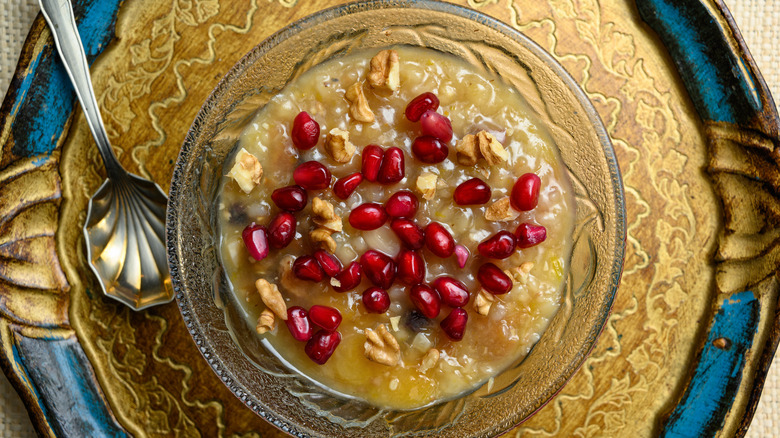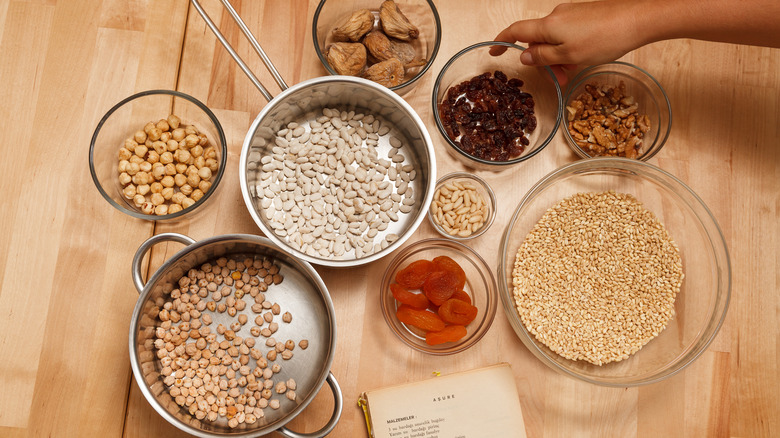How Ashure Became One Of The Oldest Desserts In The World
Throughout history and around the world, humans have sought out the comfort, pleasure, and nourishment of sweet dishes. Whether that be the very understandable preference for the sugars found in ripe fruit over unripened ones, or ancient accounts of honey being used to bring sweetness to whole ingredients like fruits and nuts, it's not hard to see that sweetness in food is a quality humans have historically cherished and sought out. But how far back can we trace actual desserts?
While there are differing opinions about what constitutes a dessert and which country created the first one, most agree that Turkish ashure takes the cake. Often referred to as Noah's Pudding, ashure is said to have been first concocted using whatever ingredients Noah's family had left in the ark to celebrate surviving the great flood, resulting in a slightly sweet, nutrient-dense dessert. The ingredients used to make ashure are central to cuisines in what was ancient Mesopotamia – where the flood is said to have taken place. That means we can likely trace this Turkish pudding back further than any other known ancient dessert. Its use of ingredients local to a broad region encompassing the Mediterranean, parts of Eastern Europe, the Levant, and the Middle East, as well as its comforting nature have ensured ashure stands the test of time.
Ashure's history and cultural significance
Though perhaps best known for giant doner kebabs, Turkish food is believed to be one of the oldest cuisines in the world and has a rich history. So the fact that the oldest dessert probably hails from this region should come as no surprise. Traditionally prepared by people in ancient Anatolia, ashure continues to have deep symbolic significance across this region. While families make and share this dessert year-round, it is most strongly associated with celebrations for The Day of Ashura, which falls on the 10th day of the first month in the Islamic calendar. That's where its name comes from, in fact — 10, in Arabic, is ashara, sometimes spelled ashra.
Although there is no singular recipe for ashure, the dessert beautifully illustrates the ingredients and priorities of ancient Anatolian cuisine — and its evolution into modern Turkish fare. Ingredients like legumes, grains, seeds, nuts, and fruits are combined to create something nutritious, accessible, and filling — but sweet and delicious, too. As we see in its connection to the Noah's Ark story, this dessert represents survival, health, abundance, and celebration. It's meant to be shared with others, and this legacy of generosity has continued for thousands of years. Turkish families prepare ashure in small bowls, keeping a portion of the pudding for themselves and distributing the rest to friends, family, and members of the community.
Preparation and variations
Though most strongly associated with Turkey, ashure has become part of other culinary traditions as well, including Armenian and Greek cuisines. The recipes vary between families, regions, and seasons, but the foundation of the pudding is consistent: grains, legumes, and nuts. To make ashure, some combination of these ingredients are soaked in water overnight, then boiled to cook and allow their skins or husks to be easily removed. Once done, cleaned ingredients are returned to a pot along with fresh water, a sweetener like sugar, honey, or grape or date molasses, and whichever fruits, nuts, and spices have been chosen (cinnamon is a popular choice).
All ingredients are boiled for 10 to 15 minutes, then portioned out and topped with additional fruits, nuts, or seeds — pomegranate, orange peel, and sesame are a few popular options. Some prefer eating ashure hot — when the texture is similar to porridge, and its warmth brings heightened comfort — while others eat it cold, with a texture more akin to custard. With seemingly endless variation and opportunities for customization, it is easy to see why ashure has prevailed longer than any other dessert and put down roots in so many cultures.



